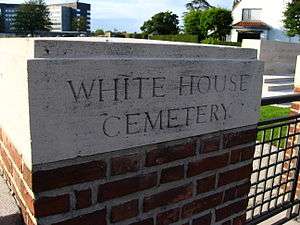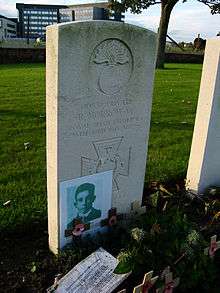White House Commonwealth War Graves Commission Cemetery
White House Cemetery is a Commonwealth War Graves Commission (CWGC) burial ground for the dead of the First World War located in the Ypres Salient on the Western Front in Belgium.
| White House, Ieper | |
|---|---|
| Commonwealth War Graves Commission | |
 | |
| Used for those deceased 1915–1918 | |
| Established | 1915 |
| Location | 50°51′43″N 02°53′55″E near |
| Designed by | Sir Reginald Blomfield |
| Total burials | 1,171 |
Unknowns | 323 |
| Burials by nation | |
Allied Powers:
| |
| Burials by war | |
World War I: 1163
World War II: 8 | |
| Statistics source: WW1Cemeteries.com and CWGC | |
The cemetery grounds were assigned to the United Kingdom in perpetuity by King Albert I of Belgium in recognition of the sacrifices made by the British Empire in the defence and liberation of Belgium during the war.[1]
Foundation
The cemetery was founded by Commonwealth troops in March 1915 and remained in use until April 1918.[2] After the Armistice in November 1918, the cemetery was enlarged by concentrating graves from eight outlying cemeteries.[2]
The cemetery was designed by Sir Reginald Blomfield[2] who was also responsible for the nearby Menin Gate memorial.[3]
Notable graves

The cemetery contains the graves of some 1,163 soldiers of the Great War. Amongst these are the graves of four men executed by the Commonwealth military authorities – Private HH Chase of the Lancashire Fusiliers, executed for cowardice on 12 June 1915; Private WJ Turpie of the Queen's Royal West Surrey Regiment, executed for desertion on 1 July 1915; and Privates RW Gawler and AE Eveleigh of The Buffs (East Kent Regiment), executed for desertion 24 February 1916.[4] Private Turpie reached the United Kingdom about a month after deserting. He was apprehended by the police and confessed to being a deserter. Brought back to the Front, he was convicted at a court martial and subsequently executed.[5] On 7 November 2006, the British government reversed its previous decision and announced a pardon for all soldiers executed in the Great War.[6]
Also buried at this cemetery is Victoria Cross-holder Private Robert Morrow of the Royal Irish Fusiliers.[4][7] World War I flying ace William Edward Green and WWII Army officer is buried here.
References
- First World War, accessed 19 August 2006
- Commonwealth War Graves Commission accessed 1 October 2006
- GreatWar.co.uk, accessed 1 October 2007
- WW1Cemeteries.com, accessed 1 October 2007
- Putkowski, JJ Shot at Dawn Campaign website on Turpie's trial, accessed 1 October 2007
- Shot at Dawn Campaign website Archived 2006-10-04 at the Wayback Machine, accessed 1 October 2007
- "Casualty Details: Morrow, Robert". Commonwealth War Graves Commission. Retrieved 3 February 2018.